Introduction
Table of Contents:
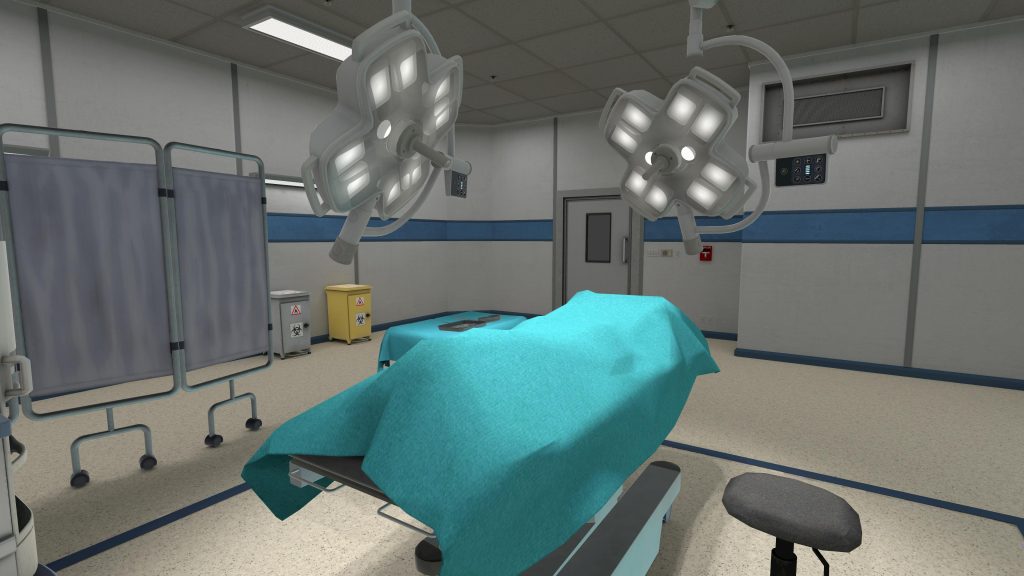
Current Use Cases of VR in Healthcare
Therapy and Mental Health:
Imagine battling your worst fears in a safe, controlled environment. That’s what Virtual Reality Exposure Therapy (VRET) offers. Whether it’s PTSD, phobias, or anxiety, VR is helping patients face their fears head-on, guided by professionals. It’s like having a personal, immersive reality show tailored to overcome mental health challenges. Studies show promising results, with patients experiencing significant improvements.For instance, the use of VR in treating PTSD among veterans has shown significant success. By immersing patients in realistic scenarios that trigger their PTSD in a controlled setting, therapists can help patients confront and process their trauma. This gradual exposure helps reduce the severity of symptoms over time.
Moreover, VR is proving to be a valuable tool in treating anxiety disorders. Patients with social anxiety, for example, can practice social interactions in virtual environments, gradually building their confidence and reducing their anxiety in real-world situations.
Surgery Simulation and Training:
Surgeons, much like pilots, need countless hours of practice. Enter VR surgical simulators. These aren’t just fancy video games—they’re lifelike, immersive training tools. Take Osso VR, for instance. This company’s VR platform allows surgeons to practice complex procedures in a risk-free environment. The precision, the realistic scenarios, and the instant feedback make it a game-changer in medical education.Research has shown that surgeons trained with VR perform better in real-life surgeries. They make fewer errors and complete procedures more efficiently. This is crucial, especially in high-stakes fields like neurosurgery and cardiovascular surgery, where even minor mistakes can have significant consequences.
In addition to improving technical skills, VR also helps in developing non-technical skills such as communication, decision-making, and teamwork. Surgeons can practice these skills in simulated high-pressure environments, better preparing them for real-life scenarios.
Pain Management:
Pain is more than a physical sensation—it’s a full-body experience. VR offers a novel approach to pain management by immersing patients in calming virtual environments. This isn’t just a distraction; it’s a therapeutic escape. Imagine being transported to a serene beach or a peaceful forest during a painful procedure. AppliedVR is leading the charge in this space, providing immersive experiences that significantly reduce pain perception.One of the most compelling uses of VR for pain management is with burn victims. Traditional burn wound care is incredibly painful, often requiring high doses of painkillers. However, studies have shown that patients immersed in VR environments during wound care report significantly lower pain levels. This reduction in pain perception can lead to lower dosages of pain medication, reducing the risk of side effects and addiction.
Its also being used to manage chronic pain conditions like fibromyalgia and complex regional pain syndrome (CRPS). Patients engage in immersive experiences that help them relax and divert their attention away from their pain, leading to improved pain management and quality of life.
Patient Education:
Medical jargon can be overwhelming. VR helps demystify complex procedures for patients, offering them a front-row seat to their own treatment plans. Through immersive experiences, patients gain a clearer understanding of their conditions and the steps involved in their care. This not only eases anxiety but also fosters informed decision-making.
For example, a patient scheduled for heart surgery can be taken on a virtual tour of their heart. They can see where the problem lies and how the surgery will fix it. This visual and interactive approach helps patients feel more comfortable and prepared for their procedures.
VR is also being used to educate patients about chronic conditions like diabetes and hypertension. By visualizing the effects of these diseases on their bodies, patients are more likely to adhere to treatment plans and make necessary lifestyle changes.
Companies Leading the Way in VR Healthcare
Osso VR
Osso VR specializes in creating hyper-realistic surgical training modules. Their platform is a favorite among medical institutions, boasting improved surgical performance and reduced errors. Surgeons can practice anytime, anywhere, honing their skills in a virtual OR.Founded by Justin Barad, a pediatric orthopedic surgeon, Osso VR aims to bridge the gap between theoretical knowledge and practical skills. The platform offers a library of surgical procedures across various specialties, complete with detailed anatomy and haptic feedback to simulate the feel of real surgery.
Their VR’s impact extends beyond individual surgeons. Hospitals and training institutions are incorporating the platform into their curriculums, ensuring that future generations of surgeons are well-prepared for the demands of the operating room.
Applied VR
Focused on therapeutic applications, AppliedVR is making significant strides in pain management. Their VR solutions are backed by research and have shown impressive results in reducing pain and anxiety.
AppliedVR’s flagship product, RelieVRx (formerly EaseVRx and now FDA approved), is designed to help patients manage chronic pain through a series of immersive experiences. The program includes guided relaxation exercises, mindfulness practices, and cognitive behavioral therapy techniques, all delivered in a virtual environment.
Clinical trials have demonstrated the efficacy of AppliedVR’s solutions. Patients using EaseVRx report significant reductions in pain intensity and improvements in their overall quality of life. These findings have earned AppliedVR FDA approval, making it one of the first VR solutions to receive such recognition.

Medical Realities
Medical Realities offers a suite of VR training modules for medical professionals. From surgical procedures to patient interactions, their immersive experiences prepare healthcare workers for real-life scenarios.Founded by Dr. Shafi Ahmed, a renowned surgeon and innovator, Medical Realities focuses on creating comprehensive training programs that combine VR, augmented reality (AR), and 360-degree video. Their platform covers a wide range of medical disciplines, from general surgery to specialized fields like neurosurgery and cardiology.
Medical Realities also emphasizes the importance of soft skills in healthcare. Their VR simulations include scenarios that require effective communication, empathy, and teamwork, ensuring that healthcare professionals are well-rounded in their training.
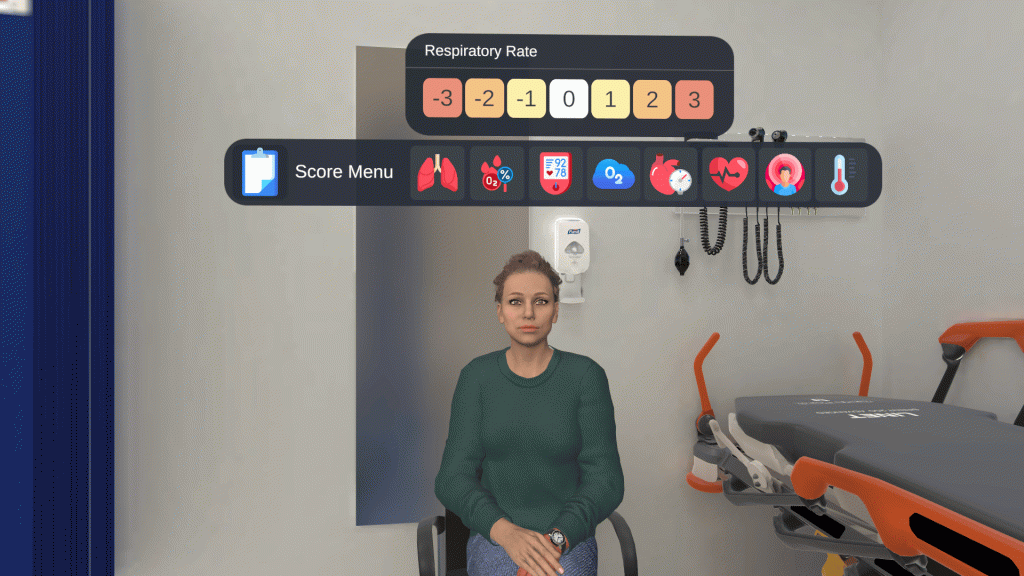
Embodied Labs
Embodied Labs takes a unique approach by focusing on caregiver training and empathy development. Their VR modules help caregivers understand and manage the challenges faced by patients with chronic conditions.One of Embodied Labs’ most notable programs is the “We Are Alfred” experience, which allows users to see the world through the eyes of Alfred, a 74-year-old man with macular degeneration and hearing loss. This immersive experience helps caregivers develop a deeper understanding of the physical and emotional challenges faced by elderly patients.
Embodied Labs also offers modules for other conditions, such as Alzheimer’s disease and end-of-life care. By fostering empathy and understanding, these VR experiences improve the quality of care provided to patients and enhance caregiver satisfaction.
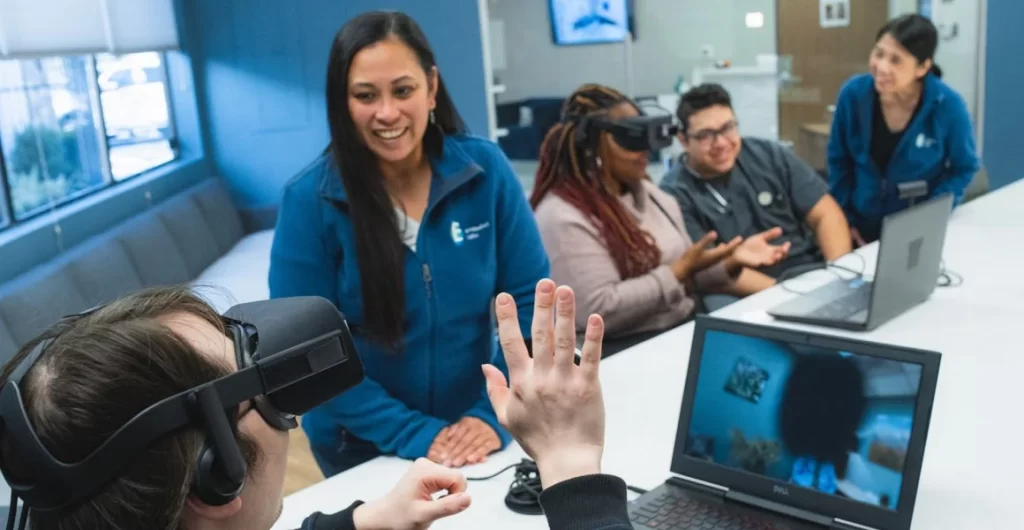
PrecisionOS
PrecisionOS is at the forefront of revolutionizing surgical training through virtual reality. By offering immersive, hands-on experiences, PrecisionOS enables surgeons to practice complex procedures in a risk-free environment, significantly enhancing their skills and confidence.
Their cutting-edge VR platform is designed to replicate real-life surgical scenarios with unparalleled accuracy, providing immediate feedback and performance analytics. This not only accelerates the learning curve but also ensures that healthcare professionals are better prepared for actual surgeries, ultimately leading to improved patient outcomes.
PrecisionOS exemplifies how VR is transforming healthcare beyond gaming, making it an invaluable tool in modern medical education and training. For examples of their work check out the capture below showcasing state of the art immersive learning simulations.
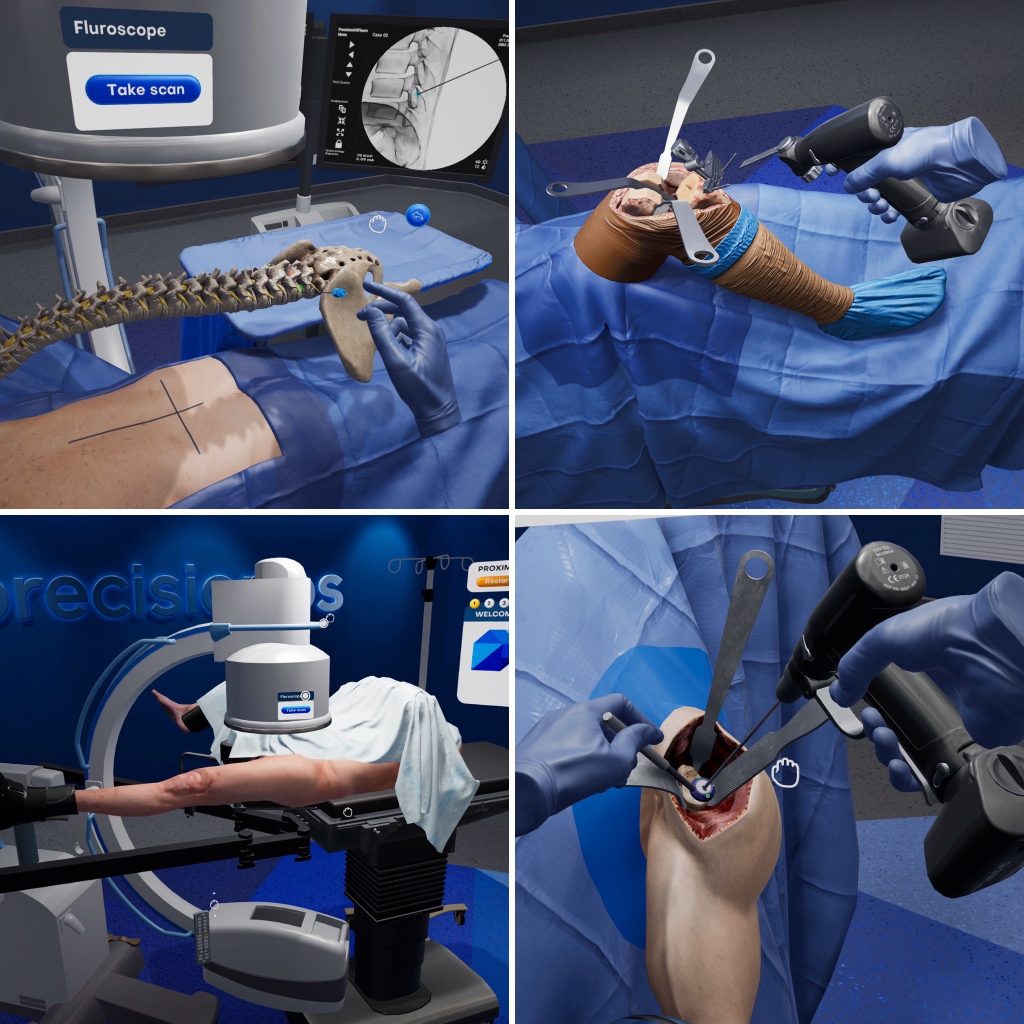
Training Applications and Job Roles
Medical and Nursing Schools
We’ve also started to see medical and nursing students are now donning VR headsets instead of white coats. VR labs allow them to practice procedures, diagnose virtual patients, and engage in interactive learning. It’s hands-on experience without the hands-on risk.
UbiSim – VR Training for Nurses For instance, a medical student can practice inserting an IV line or performing a lumbar puncture in a virtual environment before ever touching a real patient. This repetition builds confidence and competence, reducing the likelihood of errors in real-life situations.
Nursing students also benefit from VR training. They can practice patient assessments, medication administration, and emergency response procedures in a safe and controlled environment. This hands-on experience is invaluable in preparing them for the demands of the nursing profession.
Surgical Training
VR in healthcare is particularly beneficial in surgical training. Orthopedics, neurosurgery, and other specialties are seeing remarkable improvements in training outcomes. Surgeons report feeling more confident and prepared after practicing in a virtual environment.
One notable example is the use of VR in orthopedic surgery training. Surgeons can practice complex procedures like joint replacements and spinal surgeries, honing their skills and improving their technique. The realistic simulations and haptic feedback provided by VR platforms like Osso VR make the training experience as close to real surgery as possible.
Neurosurgery is another field that benefits greatly from VR training. The intricate and delicate nature of brain surgery requires precision and practice. VR simulations allow neurosurgeons to navigate the brain’s complex anatomy and practice procedures without the risk of harming real patients.
Emergency Response Training
Emergency responders need to think on their feet. VR simulations of high-pressure scenarios help EMTs and paramedics sharpen their skills and improve response times. It’s like boot camp, but without the bruises.
For example, a paramedic can practice responding to a cardiac arrest scenario in VR. They can perform CPR, administer medications, and use a defibrillator, all in a realistic virtual environment. This immersive training helps improve their skills and confidence, ensuring they are prepared for real-life emergencies.
VR is also being used to train firefighters, police officers, and military personnel. These high-stress professions require quick thinking and effective decision-making. VR simulations provide a safe and controlled environment for training, allowing responders to practice their skills and improve their performance.
Physical and Occupational Therapy
Rehabilitation is a tough journey. VR makes it a little easier by turning exercises into engaging virtual adventures. Patients are more motivated, and therapists can track progress with precision.
For instance, a patient recovering from a stroke can use VR to practice movements and exercises that help improve their motor skills. The immersive and interactive nature of VR makes the exercises more enjoyable, increasing patient engagement and adherence to the rehabilitation program.
Occupational therapists are also using VR to help patients regain their independence. Patients can practice daily activities like cooking, dressing, and driving in a virtual environment, building their confidence and skills in a safe and controlled setting.
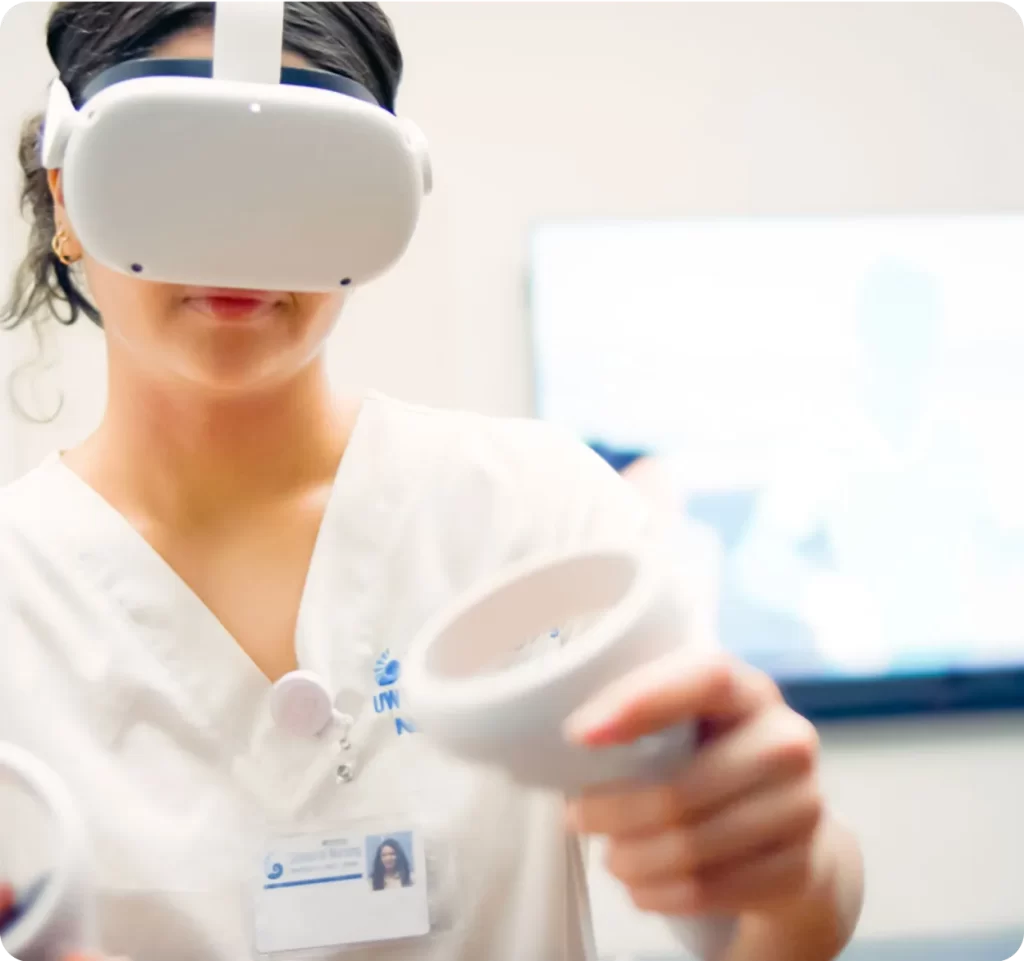
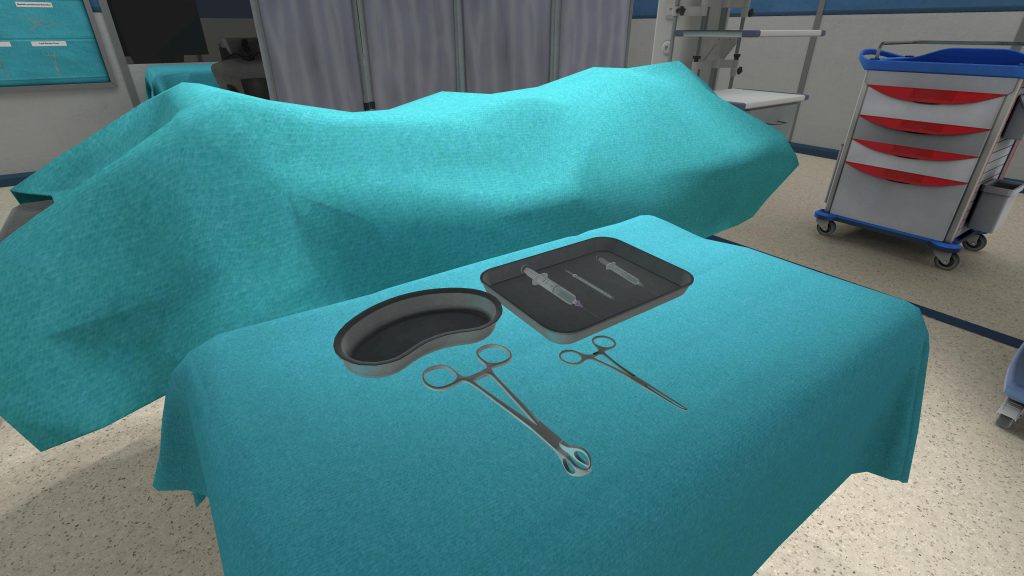
The Future of VR in Healthcare
Expansion of Current Use Cases
The future of VR in healthcare is bright. Current applications will evolve, becoming more sophisticated and widespread. We’ll see VR integrated into more medical fields, enhancing everything from diagnostics to post-operative care.
For example, VR could be used to simulate complex medical procedures for training purposes, allowing healthcare professionals to practice and perfect their skills before performing the procedures on real patients. This could lead to improved patient outcomes and reduced medical errors.
VR could also be used to enhance patient care. For instance, patients undergoing physical therapy could use VR to perform exercises and track their progress in real-time. This could make physical therapy more engaging and effective, leading to better patient outcomes.
Emerging Technologies
The marriage of VR and AI is on the horizon. Personalized medical training, real-time feedback, and adaptive learning experiences are just the beginning. Add haptic feedback, and you have an ultra-realistic training tool that mimics the feel of real-life scenarios.
For example, AI could be used to create personalized VR training programs for healthcare professionals, based on their individual needs and learning styles. This could make training more effective and efficient, leading to improved skills and performance.
Haptic feedback could be used to enhance the realism of VR simulations, allowing healthcare professionals to feel the textures and pressures associated with different medical procedures. This could improve their skills and confidence, making them better prepared for real-life scenarios.

Global Accessibility
VR has the potential to democratize medical training. Imagine VR training modules in remote villages, equipping healthcare workers with the skills they need to save lives. It’s not just a possibility; it’s an impending reality.
For instance, healthcare workers in remote areas could use VR to practice medical procedures and improve their skills. This could lead to better patient care and improved health outcomes in underserved communities.
VR could also be used to provide medical education and training to healthcare professionals in developing countries. This could help address the shortage of trained healthcare professionals in these regions, improving access to healthcare and saving lives.
The Future of Virtual Reality & Healthcare
Innovating Healthcare Through Virtual Reality
At VR Vision, we’re not just keeping up with the trends—we’re setting them. Our healthcare-related VR projects and solutions are designed to transform training and patient care.We offer a range of VR solutions for healthcare, including customizable training modules that can be developed for medical and nursing students, surgical simulations, and even therapeutic experiences. Our solutions are designed to improve skills, enhance patient care, and reduce medical errors.
For more information about our healthcare offerings, visit our virtual reality healthcare page.
Vision Portal
Our Vision Portal is a cloud-based VR training platform that’s revolutionizing healthcare education. From surgical procedures to patient care simulations, the Portal offers a comprehensive set of tools for teachers and students alike. It’s VR training, simplified and accessible.The Vision Portal is designed to be user-friendly and accessible, making it easy for healthcare professionals to access and use virtual reality training simulations with both doctors and students. The platform also includes analytics and reporting tools, allowing users to track their progress and identify areas for improvement.
Our customizable training modules have the ability to cover a wide range of medical disciplines, from general surgery to specialized fields like neurosurgery and cardiology. Each module is designed to be immersive and realistic, providing users with a hands-on learning experience.
Conclusion
The potential of VR in healthcare is vast and largely untapped. From revolutionizing surgical training to transforming patient care, VR is poised to become a cornerstone of modern medicine. If you’re a healthcare provider looking to explore VR solutions, now is the time. Contact us here at VR Vision and let’s embark on this transformative journey together.
VR is not just a tool for entertainment—it’s a powerful technology with the potential to transform healthcare. By embracing VR, we can improve training, enhance patient care, and save lives. The future of healthcare is here, and it’s virtual.